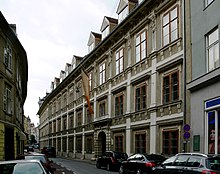Landesmuseum Joanneum

Original Joanneum building on the Raubergasse, Graz
|
|
| Established | 26 November 1811 |
|---|---|
| Location | Graz, Stainz, Trautenfels and Wagna (Flavia Solva) in the Austrian province of Styria |
| Type | Universal museum |
| Collection size | Over 4.5 million objects covering culture & fine art, nature, science & technology |
| Visitors | 494,487 (2008) 513,826 (2009) 486,762 (2010) 501,907 (2011) |
| Director | Wolfgang Muchitsch |
| Website | Official website |
The Universalmuseum Joanneum is a multidisciplinary museum with buildings in several locations in the province of Styria, Austria. It has galleries and collections in many subject areas including archaeology, geology, palaeontology, mineralogy, botany, zoology, history, art and folk culture. It is the oldest museum in Austria as well as the largest universal museum in central Europe with over 4.5 million objects in 13 departments and 12 locations in the Styrian cities of Graz, Stainz, Trautenfels, and Wagna (Flavia Solva). To reflect this status and its growth over the last two centuries, as well as to present a more recognizable image internationally, the Landesmuseum Joanneum was officially renamed to Universalmuseum Joanneum on 10 September 2009.
Established in 1811 by Archduke Johann, the Landesmuseum Joanneum was Austria’s first museum as well as a center for continuing education and scientific research. Notably, the Coin Cabinet and the mineralogical collection were extensive, private collections belonging to the archduke himself, and form the spiritual heart of the museum's departments in disciplines from both the humanities and the natural sciences. Around this core of collections, some of the best scientists of the era taught and conducted research; Friedrich Mohs developed the Mohs scale of mineral hardness here and Franz Unger, a pioneer in paleobotany, plant physiology, phytotomy and soil science, taught here. In 1864, the Joanneum entered the ranks of the "k.k. technical colleges".
...
Wikipedia
